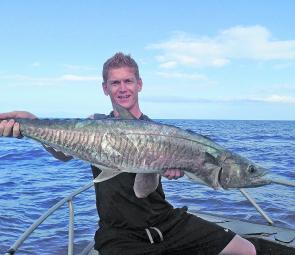April signals the start of the changeover period, and every year is a different bag of marbles. Some years the hot weather hangs on and the tropical summer species bite well into May, and in others the winter species start arriving early April. The positive is that April can bring the best of both worlds.
The fishing of late has matched the weather, with good conditions bringing the fish on the bite. Most of the time through it’s been rough going. Here’s hoping April will bring a run of good weather, especially early in the month, to coincide with the school holidays.
In the coming weeks the estuaries should see a continuation of barra, golden snapper (fingermark) and mangrove jack catches, along with an increase in the presence of trevally, queenfish, flathead and bream, as the water clears and cools.
Covering your options will be the best approach this month. To give yourself the best chance head out with the plan to try different locations and techniques until you work out what’s on the bite. Go prepared to try dead bait, live bait and lures and you should not be disappointed.
A good approach is to have two presentations on the go at once. When bait fishing, have a live bait and a dead bait out at the same time (provided you’re not fishing in a yellow zone). If anchored, it’s quite productive to have a live or dead bait in the water while flicking or jigging a lure. It’s just a matter of setting yourself up so you can quickly and safely put the luring rod down to respond to a strike on your bait rod. A conveniently placed rod holder is the best option, as dropping the lure rod on the floor is fraught with dangers and can be expensive if a freight train grabs the lure or you stand on the lure rod while battling a fish on the bait rod. And yes, unfortunately I speak from experience!
Variety with techniques should coincide with variety in your locations. If you spend half an hour at a location trying different techniques with no result, it’s time to move. If you started off fishing the flats, for example, try some deep water. Alternatively, if you started out focusing on snags, look for some rock or rubble areas. If it’s quiet around the mouth, head upstream – provided there isn’t too much fresh in the system.
Dropping the crab pots in before wetting a line also adds another string to your bow. Many a trip has turned from tribulation to triumph by pulling a feed of crabs from the pots on the way home. Have the cast net handy and keep a close eye out for flicking prawns around drain mouths and flats. A single skipping prawn can indicate a large school.
Egrets and herons are another good indicator of prawns and baitfish. These birds know where the bait is far better than we do, so use them to put you onto the action. That applies equally to chasing predators as it does to chasing bait and prawns. An egret will invariably be watching a school of bait or prawns and often gets assistance from predators pushing the bait to the surface or into the shallows. If you flick a lure or live bait close to a hunting heron you’ll find it’s often worth the effort – especially if your presentation matches the bait that the bird is stalking.
Calm conditions will allow small boats to venture to close inshore reefs and islands, and April can turn it on in these areas if the weather cooperates. Golden snapper will be on the chew on the rubble and reef areas, and queenfish, trevally and the odd early mackerel will be active on the pressure points, current lines, pinnacles and wrecks.
Once again, try a variety of techniques and locations in your quest to find the action. The wrecks, wonky holes and deep water rubble areas should turn up a few large-mouth nannygai (saddletail snapper), gold-spot cod and golden snapper, especially at night.
If weather permits, the reef can really turn it on this month, with large mouth nannygai and red emperor the main players in the deep water and coral trout up shallow. Add to that a sprinkling of small-mouth nannygai (crimson snapper), reef red bream (large mangrove jack), spangled emperor, stripies and trevally, and there will be plenty to keep you amused.
The odd Spanish mackerel will be around, so always have a floating bait of some kind out the back. Early in the season, the garden variety pilchard on a set of ganged hooks can often out-fish all other presentations. It is a good idea to cast the pilchard out and let it slowly sink, to try to locate feeding fish. Often they are quite deep early in the season. Some anglers even target mackerel using a whole pilchard on a dropper rig, when they are sitting tight to the bottom. A few bite-offs on your reef rig can often indicate Spaniards feeding on the bottom. The more serious pelagic anglers will find a few northern bluefin tuna, yellowfin tuna, mack tuna and cobia about if they put in the time.
April can be a magic time on the water when the weather gods cooperate. Not too hot, not too cold and the fishing just right.
Reads: 1365
Drifting a ganged pilchard down through the water column can produce the odd good Spaniard, like this one taken aboard Blackout Sportsfishing Charters.




